Great Vespers of Consecration

The metropolitan conducts a short Prayer Service honoring the memory of the Martyrs, followed by the Great Vespers of Consecration.
The Consecration Vespers service features hymns that emphasize the central theme of the Consecration, which is renewal, as well as hymns from the Church’s patron saint’s feast day.
The decorated icon of the church’s patron saint is then carried in a procession around the church.

An Artoklasia service (Blessing of the loaves) is held during Vespers. The five loaves offered represent the five loaves blessed by Christ in the desert and by which five thousand of His hearers were fed. Since ancient times, the blessed bread has been considered to affect personal sanctification and guard against bodily infirmities and illness, if taken with faith.
The Consecration
The day of Consecration begins early on Sunday morning with Metropolitan Methodios officiating the Orthros service. As the faithful enter the church, the altar is still uncovered. The only items upon it are the relics on the covered paten and a vigil light. The new altar articles have been placed on a table on the solea.
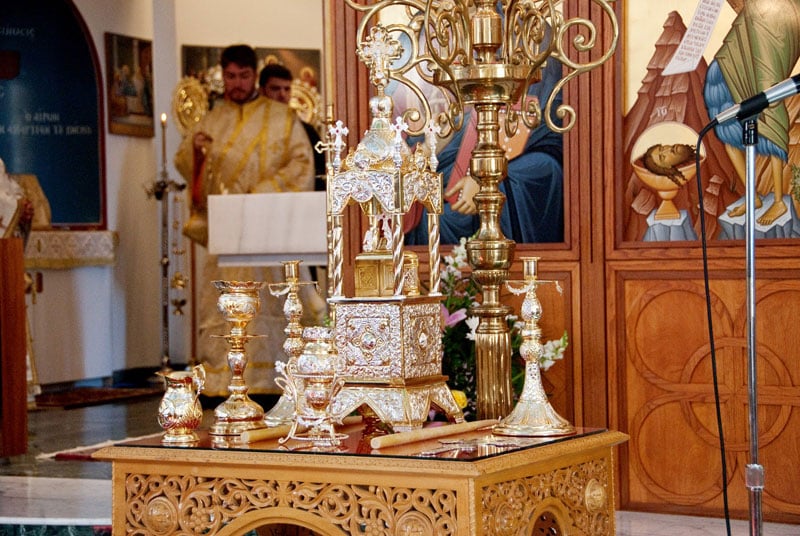
Following the Orthros service the Consecration service begins. After the reading of Psalm 143 and the Small Litany, the metropolitan reads the prayer:
Lord our God, at the intercessions of our Holy Lady, Mother of God, and of all Your Saints, direct the works of the hands of Your unworthy servants, and make us worthy to be well-pleasing to your goodness.
Blessed and glorified be the power of Your kingdom, of the Father, and of the Son and of the Holy Spirit, now and ever and to the ages of ages.
Following the prayer, the metropolitan and clergy, together with all the faithful, prepared for the three processions around the church. The three processions represent the setting aside of an area which will be separate and sacred from all other areas, especially and exclusively for the purpose of worshipping God.
The procession is led by the altar boys, the choir and chanters, the children carrying the new altar articles, the priests, the metropolitan carrying the relics, and the faithful. The church is left completely empty.As the procession begins, the chanters and choir chant the following hymn:
Holy Martyrs, who fought the good fight and received your crowns, intercede with the Lord to have mercy on our souls.
Glory to You, Christ God, the boast of Apostles, the joy of Martyrs, whose preaching was the consubstantial Trinity.

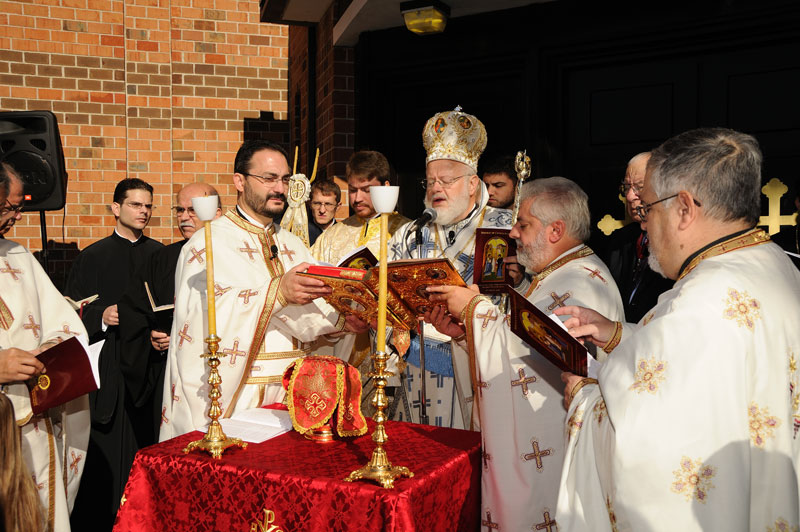
When the procession reaches the main doors of the church, the metropolitan places the Holy Relics on the table that has been placed before the doors. After the Gospel reading, the metropolitan raises the Holy Relics and processes around the church with the clergy and the faithful a second time.
The metropolitan raises the Holy Relics a third time and processes around the church with the clergy and the faithful. At the end of the Third Procession the metropolitan again places the Holy Relics on the table.
The metropolitan, standing in front of the doors of the church that were still closed, began a short dialogue. The words of this dialogue are taken from Psalm 24. This represents Christ the King entering and proving His authority in and over His Church. The metropolitan raises his Hierarchical staff (Ravdos) and knocks on the doors of the Church.

From inside the Church and behind the closed doors, the priest answered.
At the third response the metropolitan once again lifts the Holy Relics from the table and makes the sign of the Cross with them three times in front of the closed doors. As soon as the third response is completed, the Godparent of the Church comes forward and assists the metropolitan in turning the key which opens the doors of the church. When they had been opened, the metropolitan enters the church carrying the Holy Relics followed by the Godparent and representatives of the various church organizations. They are followed by the clergy, the chanters, the choir, the altar boys, the children carrying the Altar Articles, and the congregation.
The metropolitan places the Holy Relics on the Holy Altar. Uncovering the Paten and placing the Holy Relics in the small reliquary (a small silver box) prepared for them. The relics are very small bone fragments that are adhered to the paten by wax so as to remain affixed during the procession. Holy Myron is poured over them three times representing the union between our Lord and His Martyrs. While doing this the metropolitan prays for the founders of the Church.

The metropolitan put on a white linen garment called a Savanon. In addition to protecting his vestments, the white cloth represents the cloth with which Joseph of Arimathea wrapped the body of Jesus before placing It in the tomb.
With great care the metropolitan places the reliquary containing the Holy Relics into the cavity that has been cut into the center of the Holy Altar Table, where it will remain permanently. The metropolitan uses wax-mastic to seal the Holy Relics into the cavity of the Holy Altar Table. Mastic is a resin used to make incense. The mastic is mixed with wax, myrrh, aloe, incense and labdanum to create and cementing compound. The metropolitan first pours the wax-mastic over the silver box, and then places in the cavity the names of parishioners, both living and department, that have been printed on tiny scrolls. The parishioners, as members of the undivided Body of Christ, are thus sealed together with the Martyrs for all ages. He then fills the cavity with powdered marble. A final layer of wax-mastic is poured to fill the entire cavity. The marble slab is placed over the opening and sealed with the wax-mastic.
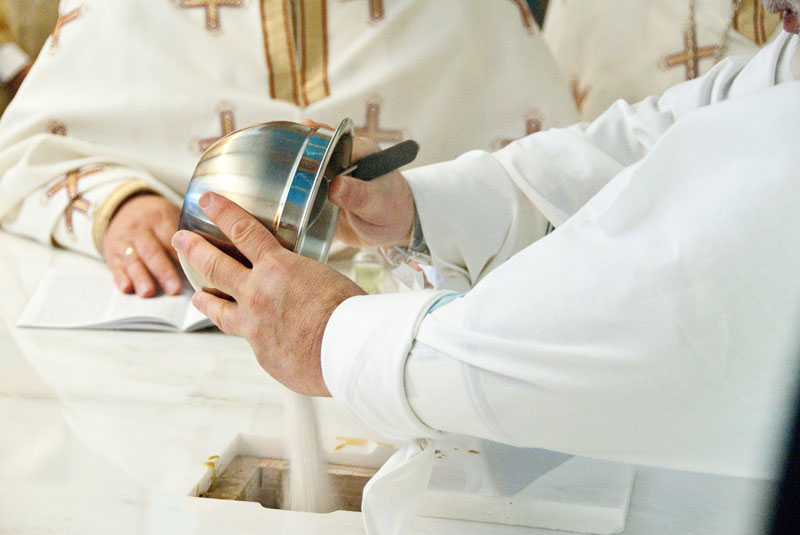
The metropolitan removes the excess wax-mastic. A Psalm is read that refers to Baptism, Holy Chrism, the Cup and the Table which bears the Holy Bread. The deposition of the Holy Relics now completed, the metropolitan prepares to wash and anoint the Holy Altar Table.
While the faithful kneel, the metropolitan reads the prayer of Consecration. This prayer emphasizes renewal, referring to the power of God that causes nature to renew itself and helps man through the working of the Holy Spirit to renew himself. The word “renewal” in Greek is “Engainia” and the ritual of Consecration is called “Engainia” in Greek.
The metropolitan, standing in front of the Holy Altar Table, takes three pieces of soap and makes the sign of the Cross over them. A basin of warm water is brought to the metropolitan who prays over it in a low voice. The metropolitan pours the blessed water on the Holy Altar Table three times in the form of the Cross. After washing the Holy Altar Table with the pieces of soap, the metropolitan takes a new sponge and dries the Holy Altar Table.
Antimension, which means “in place of a table,” is a piece of cloth received from the Ecumenical Patriarch on which Christ’s Burial is depicted. The Divine Liturgy is always celebrated on the Antimension. The Antimensia are thus Consecrated along with the Church and the Holy Altar. The metropolitan had inscribed the Antimensia with the name of the church for which they have been consecrated, signed them and stamped them with his official seal.
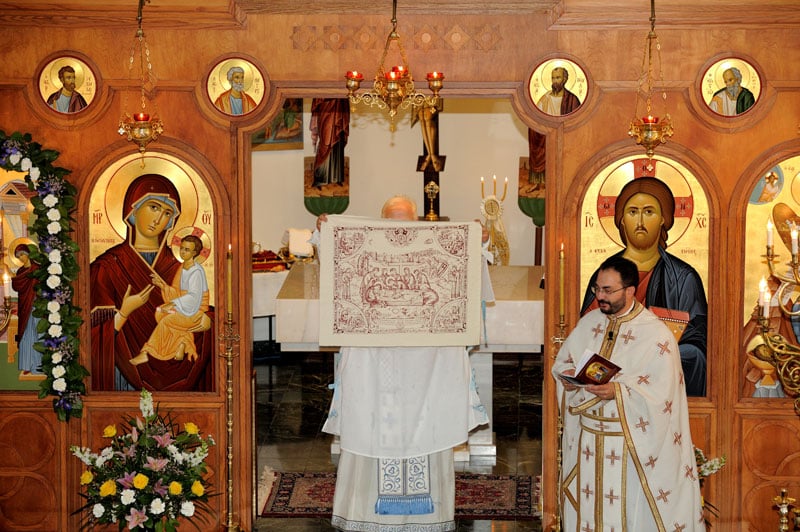
With the priests standing close, the metropolitan, having placed Antimensia on the four corners of the Holy Altar Table, takes rose water (a sweet smelling fragrance which was used to anoint the Body of Christ for burial) and fragrant wine, mingles them, and pours them on the Holy Altar Table three times, making the sign of the Cross, while chanting the following Psalm:
Purify me with hyssop, and I shall be clean; wash me, and I shall be whiter than snow. Make me to hear joy and gladness, let the bones which you have broken rejoice.
While the Psalm is repeated, the metropolitan washes the Holy Altar Table with the rose water and fragrant wine, and then wipes it dry with the Antimensia.
The metropolitan next takes a vessel filled with pure Holy Myron mixed with olive oil. Holy Myron, also known as Holy Chrism, is Holy Oil which contains many fragrant ingredients. It is mixed and blessed by the Ecumenical Patriarch during a special service on Holy Thursday once every 10 years and distributed to all churches in his care. It is primarily used for the celebration of the sacrament of Holy Chrismation. The metropolitan pours the Holy Myron onto the Holy Altar Table in the form of a Cross and chants “Alleluia” three times, as at a Baptism. “Alleluia” is a prophetic hymn that signifies the presence and praise of God. He spreads the Holy Myron over the entire Holy Altar Table with his hands.
When the Holy Altar Table has been wiped with the Antimensia to absorb the excess Holy Myron, the Antimensia are laid aside again by the priests on a designated table in the sanctuary. By absorbing the Holy Myron, the Antimensia become consecrated themselves.
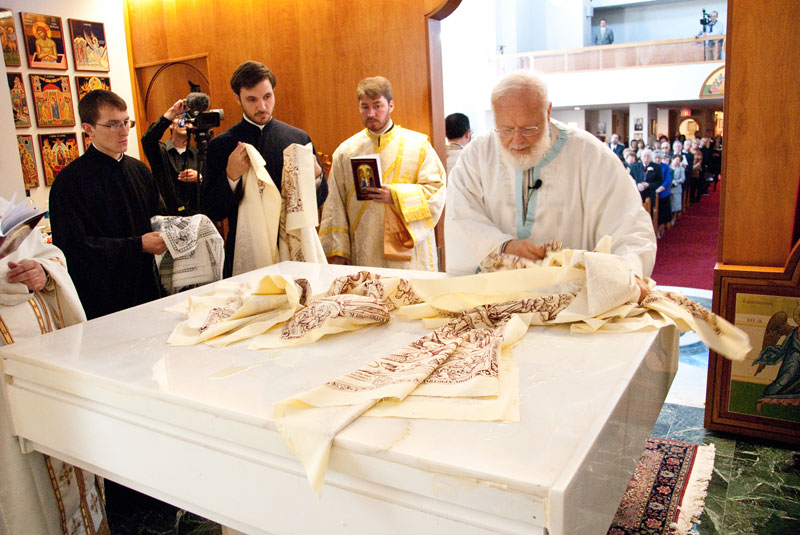
Then at the four corners of the Holy Altar Table, the four clothes (Hyphasmata) with the icons of the four Evangelists, are affixed with wax-mastic. The completed Altar represents the entire Church, which from the four corners of the world is held together by the Lord, and is built on Him through the preaching of the Gospel.
After this the metropolitan washes his hands in a new vessel, so that not a single drop of the Holy Myron falls anywhere on the floor, and dries them with a new towel with great care and devotion.
The Holy Altar Table is then covered with the Katasarkion. This white linen cloth represents the Lord’s burial shroud. The Katasarkion is tied with a cord which represents the cord with which our Lord’s hands were bound as He stood before the High Priests. The Katasarkion will never be removed and will remain on the Altar for as long as the Church remains standing. The metropolitan then covers the Altar Table with a brighter and more elaborate cover which symbolizes the Glory of God since the Holy Altar represents the Throne of God.
The metropolitan places the Artoforion (Tabernacle) in which the Body and Blood of our Lord are placed and reserved for Communion for the sick on the Altar Table. The Artoforion, an elaborate gold and silver box with a Cross-bearing dome, is symbolic of the presence of our Lord. The candlesticks which were placed next represent the Light of Christ that shines forth during the Sacred Services.
The metropolitan then unfolds the Antimensia on the Altar Table and places them one on top of another. He then unfolds on them the Antimensia of the Church. On top of this is placed the Holy Gospel Book that represents the teachings of Christ.
The Holy Altar, having been consecrated, sanctified, and adorned with all its furnishings, is censed by the metropolitan who then censes the Sanctuary and the whole Church.

After censing, the metropolitan, carrying a reed on the tip of which a sponge dipped in Holy Myron has been placed, draws the sign of the Cross in the apse of the Sanctuary (Platytera), on the four columns (Icons of the Evangelists) and on every icon in the church. This act symbolizes the sanctification of all creation with the Grace of Christ. Upon completion of the Anointing, the metropolitan offers prayers for the Holy Altar and the Church. He then blesses the faithful and offers another prayer for the Holy Altar Table. He asked God to fill this Altar with His Grace so that the Bloodless Sacrifice may be offered upon it.
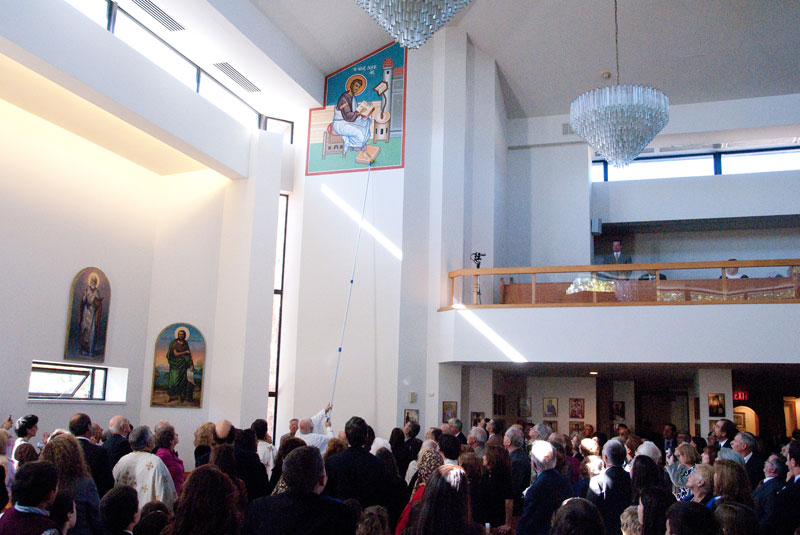
During the service the metropolitan invites the faithful to come forward and to offer a few drops of oil in a Vigil Lamp (Kandili). They did this as an offering to the Church. Towards the end of the service the metropolitan then lights the Vigil Lamp and places it on the Holy Altar Table near the Artoforion. This light will be kept burning at all times and is symbolic of the Church of Christ as it shines forth with the light of grace to enlighten all people.
The metropolitan removes the Savanon and has it cut into small pieces to be given to everyone in attendance as a Phylacton, a blessed keepsake of the Consecration.
Immediately following the service of Consecration, the metropolitan begins the Divine Liturgy by proclaiming “Blessed is the kingdom of the Father and of the Son and of the Holy Spirit, now and ever and to the ages of ages.” This is one of the only times a Hierarch begins the Liturgy instead of a priest.
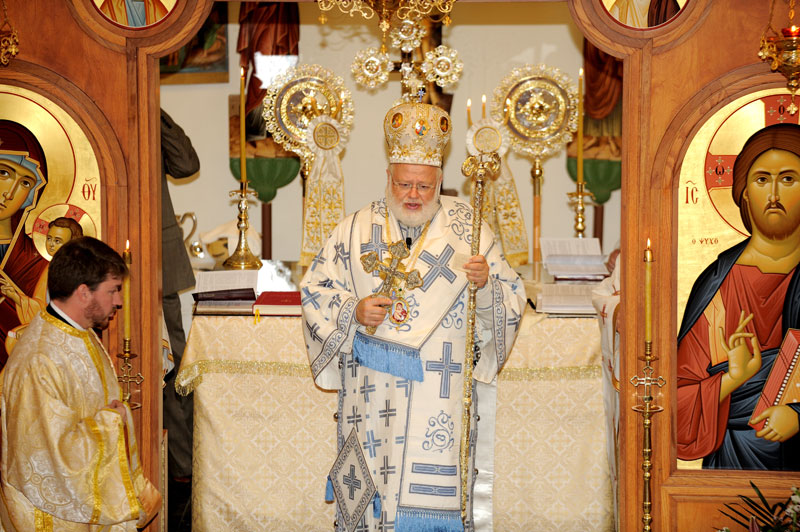
The contents of this article are adapted from the Consecration Booklet from Annunciation Greek Orthodox Church of Brockton, MA and used with permission.